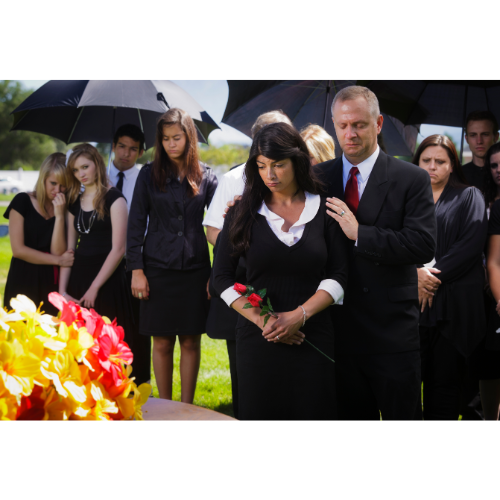Learn about the rising funeral costs in the United States, the average cost of a funeral, factors influencing expenses, different funeral options, tips for planning a funeral on a budget, and ways to cover funeral costs.

Rising Funeral Costs in the United States
The average cost of funerals in the United States has experienced a notable upward trend, with expenses rising by almost 8% over the past five years. This increase has been a cause of concern for many families, as it adds to the financial burden during an already challenging and emotional time. For instance, the median cost of a funeral with a viewing and burial is $7,848, while a funeral with cremation costs $6,970, making it essential for individuals to plan ahead and consider the financial implications of end-of-life arrangements.
The surge in funeral costs highlights the necessity of being financially prepared for unexpected expenses. Families are encouraged to explore various options for covering funeral costs, including life insurance, burial insurance, and government assistance programs. Furthermore, it underscores the importance of open communication within families to ensure that everyone is aware of the potential financial impact of funeral expenses, thereby minimizing the burden on loved ones during an already challenging time. This increase also emphasizes the need for individuals to be well-informed about their rights under The Funeral Rule, enabling them to make informed decisions and have control over the funeral planning process.
The Average Cost of a Funeral
The rising costs of funerals in the United States have become a significant concern, with expenses increasing by almost 8% over the past five years. This trend has made it increasingly important for individuals to understand and prepare for these costs to alleviate potential financial burdens.
When considering the average cost of a funeral, it’s essential to note that the median cost of a traditional funeral, including a viewing and burial, is $7,848, while a funeral with cremation comes in slightly lower at $6,970. These expenses encompass a wide range of items, including funeral service fees, facilities for viewing and ceremony, caskets, cremation, urns, transfer of remains, embalming, and more. For instance, the cost of a casket alone can contribute significantly to the overall expenses, with wooden burial caskets having a median cost of $3,000. It’s imperative for individuals to be aware of these costs and plan accordingly to prevent any additional financial and emotional burden on their loved ones.
In light of these figures, it is clear that individuals need to be proactive in understanding and planning for funeral expenses. By being aware of the average costs and the specific elements that contribute to these expenses, individuals can make informed decisions and take steps to manage these costs effectively. This may involve exploring different funeral options, understanding the factors that influence expenses, and seeking out cost-saving strategies to ensure financial preparedness for such an important event.
Factors Influencing Funeral Expenses
When it comes to the cost of a funeral, several factors play a significant role in determining the overall expenses. One of the primary considerations is the choice between burial and cremation. A traditional burial involving a casket, cemetery plot, and headstone typically incurs higher costs compared to cremation, which involves less expensive options such as an urn and may not require a cemetery plot. The choice between these two options can have a substantial impact on the total expenses, making it essential for individuals and families to carefully consider their preferences and budget constraints.
Additionally, the selection of a casket is a major factor influencing funeral expenses. The cost of caskets can vary widely, with wooden burial caskets having a median cost of $3,000. Opting for a more affordable casket or considering alternative options can significantly reduce the overall expenses associated with the funeral. Furthermore, the need for additional services such as embalming, cosmetic services, and funeral plots can further contribute to the total cost. Consumers have the right to be informed about these services and their associated costs under The Funeral Rule, which ensures transparency and empowers individuals to make informed decisions that align with their budget. This underscores the importance of understanding these factors and making choices that are both meaningful and financially manageable.
Different Funeral Options and Their Costs
When considering funeral options, it’s essential to understand the cost disparities between traditional burials and cremation services. The median cost of a funeral with a viewing and burial is $7,848, while a funeral with cremation costs $6,970. This significant cost difference highlights the importance of exploring alternative options to manage funeral expenses effectively. For example, direct cremation, which has an average cost ranging from $1,000 to $2,200, offers a more affordable choice for individuals and families.
Choosing between different funeral options not only impacts the financial aspect but also plays a crucial role in honoring the wishes of the deceased. By understanding these cost disparities, individuals can make informed decisions that align with their budget and respect the preferences of their loved ones. It’s important to weigh the costs and benefits of each option to ensure that the chosen funeral arrangement provides a meaningful and respectful way to commemorate the life of the deceased while managing expenses effectively. Therefore, it’s advisable to carefully consider the available options and their associated costs to make a well-informed decision that meets both financial and emotional needs.
Tips for Planning a Funeral on a Budget
When it comes to planning a funeral on a budget, there are several practical tips that can help alleviate the financial strain. One effective strategy is to obtain price lists from multiple funeral homes. By comparing the costs of various services and facilities, individuals can make informed decisions about which options best suit their budget and preferences. This proactive approach empowers families to avoid overspending and ensures that they only pay for the services and products they truly need.
In addition to comparing prices, exploring eco-friendly burial options can also lead to substantial cost savings. Eco-friendly or green burials typically involve natural decomposition of the body without embalming or the use of non-biodegradable materials. These environmentally conscious alternatives not only reduce the ecological impact of traditional funerals but also tend to be more affordable. By choosing a green burial, families can honor their loved ones in a meaningful way while managing expenses effectively.
Furthermore, it’s essential to investigate potential government benefits that may be available to help cover funeral costs. Depending on individual circumstances, there may be financial assistance programs or resources offered by local or state authorities to support families during this challenging time. By understanding and accessing these options, individuals can mitigate the financial burden associated with funeral expenses, ensuring a dignified farewell for their loved ones without incurring overwhelming costs.
To explore more tips and resources for planning a funeral on a budget, individuals can visit Best Priced Funerals’ website at https://www.bestpricedfunerals.com/ for valuable insights and guidance.
Covering Funeral Costs
The rising costs of funerals have become a significant concern for many individuals and families in the United States. With expenses increasing by nearly 8% over the past five years, it has become increasingly important to understand and prepare for these costs to alleviate financial burdens. The median cost of a funeral with a viewing and burial is $7,848, while a funeral with cremation costs $6,970. These costs encompass various expenses, including funeral service fees, facilities for viewing and ceremony, caskets, cremation, urns, transfer of remains, embalming, and more.
One of the most crucial aspects of preparing for funeral expenses is exploring the various ways to cover these costs. Life insurance is often highlighted as a reliable option to alleviate the financial burden associated with funerals. It provides a safety net for families, ensuring that they are not overwhelmed by the costs of a funeral. By utilizing life insurance, individuals can secure the funds needed to cover funeral expenses, allowing their loved ones to focus on cherishing memories instead of financial stress. Readers are encouraged to explore options on Best Priced Funerals’ website for more details on how life insurance can help cover funeral expenses and provide valuable insights into available coverage options.
Conclusion
Understanding the average cost of funerals and the factors that influence expenses is crucial for individuals and families as they plan for end-of-life arrangements. The rising funeral costs in the United States, which have increased by nearly 8% over the past five years, highlight the importance of being financially prepared for these expenses. By staying informed about the median cost of a funeral with a viewing and burial at $7,848, individuals can make informed decisions about their funeral arrangements and avoid unexpected financial burdens.
Furthermore, exploring different funeral options and their costs, such as traditional burials and cremation services, provides individuals with a clearer understanding of the financial implications of their choices. For instance, highlighting the affordability of direct cremation as an alternative to a traditional funeral, with an average cost of $1,000 to $2,200, empowers individuals to consider cost-effective options. Additionally, delving into practical budget planning tips, such as obtaining price lists from multiple funeral homes and exploring eco-friendly burials, equips individuals with the knowledge to make financially sound decisions during a challenging time.
For valuable resources and additional insights on funeral planning, readers are encouraged to explore Best Priced Funerals’ website, where they can access comprehensive information and tips to make informed and cost-effective decisions regarding funeral arrangements.

